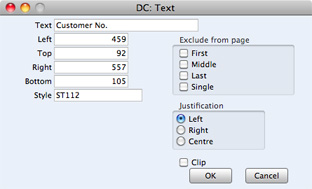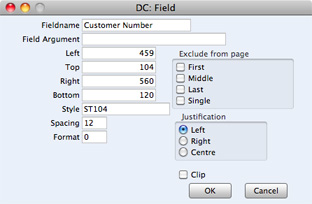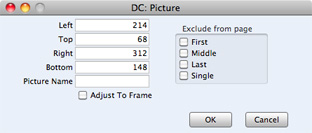Designing Forms - Adding and Editing Objects
To add an object to the Form, click the appropriate button at the top of the window and then draw a box with the mouse in the Form where you want the object to appear. When you release the mouse button, a dialogue box will be opened, where you can place the object more precisely using coordinates, specify a font style and so on. To edit an object, double-click on it with the mouse. The same dialogue box will open, where you can edit the specifications of the object. Each object type has its own dialogue box, described below.
Text Objects
To add a new text object to the Form, click the [Text] button and then draw the object where you want the text to appear.
When you release the mouse button, the following dialogue box will appear:

- Text
- The text that is to be printed on the Form. This can be up to 80 characters long, but it is limited to one line. To create a text area with more than one line, use the appropriate number of separate one-line text objects.
- Left, Top, Right, Bottom
- Use these fields to specify the size and position of the text box that is to contain the text. When you create a new text box, the measurements of the box that you have just drawn will appear here.
- Style
- Paste Special
Style register or setting
Use this field to assign a font and font style to the text. You should define your Styles using a separate register or setting (depending on the Standard product you are using) that is fully described here. If you do not enter a Style here, the first record in the Style register or setting will be used.
- Exclude from page
- Please refer to the Single- and Multi-Page Forms page for details about these options.
- Justification
- Use these options to specify where the text will appear inside the text box.
Click [OK] to close. The text field is visible on the screen, and you can move it across the Form with the mouse.
To edit a text object once it has been created, double-click it to open the 'Text' dialogue box.
Lines and Frames
Use these tool buttons to draw lines and frames on the Form. Click either button and then draw the object. When you release the mouse button, a dialogue box will appear where you can indicate the width in pixels of the line or frame, and the pages on which it is to be printed.
Fields
A field is an area on the Form where a piece of information from your Standard database is to be printed. The following example from an Invoice Form explains how:

Fields are shown as boxes containing the field name. The boxes are for identification only: they will not be printed. You can use the [Frame] button to add a printing frame if necessary. Above each field is a text object (created using the [Text] button as described above) that identifies the information shown in the field. These would not be necessary if the Form is to be printed on pre-printed stationery. Text objects can be distinguished from fields as they are unboxed.
To add a field, click the [Field] button, and mark the position of the field. A dialogue box opens:

- Fieldname
- Paste Special
Fields for the Document Type
- Enter the Field Name using 'Paste Special'. If you have assigned a Document Type to the Form as described here, 'Paste Special' will only list the fields for that Document Type. Otherwise it will list all fields. Fields belonging to other Document Types will not be printed.
- Field Argument
- You can use the Field Argument with certain fields to control how they will be printed. For example, in some fields you can use the Field Argument to specify the number of decimal places that will be printed. The Field Argument can only be used with a few fields: please refer to the descriptions of the individual documents for details.
- Left, Top, Right, Bottom
- Use these fields to specify the size and position of the text box that is to contain the text. When you create a new text box, the measurements of the box that you have just drawn will appear here.
- Style
- Paste Special
Style register or setting
Use this field to assign a font and font style to the text. You should define your Styles using a separate register or setting (depending on the Standard product you are using) that is fully described here. If you do not enter a Style here, the first record in the Style register or setting will be used.
- Spacing
- Some fields will cause more than one line of text to be printed (e.g. the fields listing the Items in Invoices). In these fields, you should use the Spacing field to specify the spacing between lines (in pixels). Usually the number of pixels that you specify here should be the same as the font size. If you leave this field empty, the lines of text will be printed on top of each other.
- Format
- In the case of matrix fields (for example, those printing the Items in Invoices), you should enter "1" as the Format (as well as specifying a Spacing). If the Format is 0, the printed matrix columns may not be aligned correctly if the first row only contains text.
- Exclude from page
- Please refer to the Single- and Multi-Page Forms page for details about these options.
- Justification
- Use these options to specify where the text will appear inside the text box.
Click [OK] to save.
Usually each field that you place in a Form corresponds to a field in the original record. For example, the Customer Number field in the illustration above will print the contents of the Customer Number field in each Invoice. An exception is the "Note" field. If you include the "Note" field in your Form design, this will print the first note or comment that you attach to the original record using the Attachments feature.
Pictures
Use the [Picture] button to include a picture in your design. As with other tools, click the button and draw a frame for the picture on the Form. A dialogue box then appears.

In the Picture Name field, enter the file name of the picture as it is on your hard disk. You can use 'Paste Special' to ensure that the file name is spelt correctly and that the path is correct.
The picture must be a PDF or PICT file. If you will use the Form to create pdf files, the only picture format that is supported is 24-bit BMP. This applies when the pdf file will be generated by the Standard application (i.e. not by your computer's operating system). Please refer here for details about pdf generation. If you will use the Form to create pdf files and will also print it on a printer, you should have versions of each picture on your computer in each format, and you should use the [Picture] button to include all versions in your Form design (i.e. you should have BMP and PDF/PICT picture objects in the same position in each Form). This will ensure the picture will always be printed correctly.
All picture file names should have the correct extensions.
When you design a Form, PDF and PICT pictures will be visible immediately in the Form editor. 24-bit BMP images will not be visible and instead will be marked by rectangular placeholders of the appropriate size.
---
In this chapter:
Go back to home pages for:
